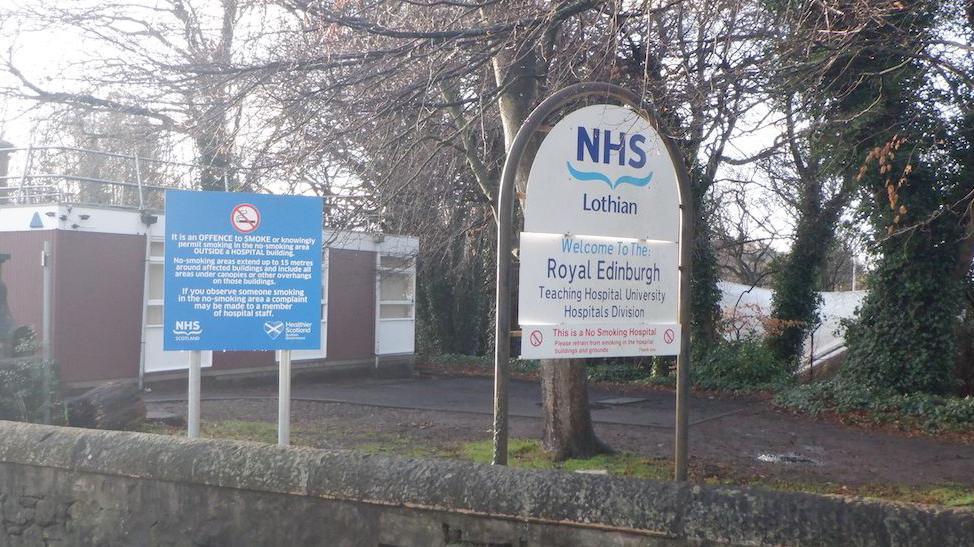Hospital ordered to make more suicide risk checks

An unannounced inspection of the Royal Edinburgh psychiatric hospital took place in June
- Published
A health board has been ordered to assess all suicide risk points at its acute psychiatric hospital.
Healthcare Improvement Scotland (HIS) issued 21 requirements for improvement, including carrying out assessments of ligature points, after the watchdog's inspection at the Royal Edinburgh Hospital (REH).
It comes fives years after the suicide of REH patient Sara MacRae, where the door of her room at the hospital had been assessed as a "high risk" but not replaced due to budget cuts.
NHS Lothian said it took patient safety "extremely seriously" and had taken immediate action to address many of the concerns raised by HIS.
The unannounced inspection of the REH took place in June and its findings included six areas of good practice such as the positive impact of the daily nursing huddles.
But there were also four recommendations and 21 requirements for improvement.
These included providing adequate training, addressing staff vacancy rates, reducing the number of medication incidents and replacing non-compliant fire doors.
Donna Maclean, HIS chief inspector, said her team witnessed "person-centred care and treatment" as well as "kind and respectful interactions between staff and patients".
She added: "Staff were open and transparent about the current challenges they face in relation to the use of non-standard care areas throughout the hospital.
"During our inspection we raised several concerns with senior managers relating to the care of patients within non-standard care areas.
"Issues around unassessed ligature points, environmental challenges and the ability of staff to be able to carry out continuous observations were also highlighted."
Patient number pressures
Due to high patient demand, the REH had created extra bed space in non-standard areas - such as interview rooms - at the time of the inspection.
HIS said it did not support the routine use of additional beds in non-standard care areas as it can lead to a drop in the standard of care provided.
While hospital workers should have been carrying out "continuous interventions" with patients being cared for in these additional beds, HIS inspectors said the majority of staff were seen "sitting outside the patient's room" with some observed on their mobile phones at times.
In the inspection they observed these rooms contained furniture, including filing cabinets and desks, which may have presented a ligature risk and managers at the hospital removed them.
Overall, inspectors observed "inconsistencies with ligature risk assessments not being completed, a lack of oversight in the risk of ligature points in additional non-standard care areas and a low rate of training compliance for ligature risk assessment".
Some work on ligature reduction in patient bedrooms has been completed, inspectors were told, but the project has stalled due to a lack of available funding.
HIS said the health board had to "ensure environmental ligature risks are assessed" and that any identified risks are robustly mitigated.

Dr Sara MacRae, who died at the REH in 2020, with her son Christopher
There have been longstanding concerns about self-harm prevention measures at the REH.
It was a theme of the fatal accident inquiry (FAI) into the death of former psychiatrist Dr Sara MacRae, who killed herself in her room at the facility in 2020.
The FAI heard how her son Christopher MacRae gave a nurse "clear evidence" that his mother was planning her suicide just hours before she died.
It also heard the door in Dr MacRae's room had been assessed as a "high risk" for suicide attempts the year before she took her own life but work to upgrade all the REH's single bedroom doors had stalled - despite the project being described as "urgent" in 2022.
In its final ruling, published last December, the inquiry said staff missed a number of chances to prevent Dr MacRae taking her own life.
At the time NHS Lothian said a review was carried out after the death which led to an extensive improvement action plan.
On the HIS report, Jim Crombie, deputy chief executive of NHS Lothian, said: "We take patient safety extremely seriously and took immediate action to address many of the concerns raised in the report.
"A structured plan to reconfigure wards to add extra permanent beds where needed is almost complete. This will end the use of temporary, non-standard areas and the divert suite, which were set up in response to demand.
"Additional leadership oversight and staff training are in place to improve the quality and consistency of ligature inspections, assessments and observations to further reduce the risk of patient self-harm or suicide."
Mr Crombie also pointed out the board had also recently recruited 97 newly qualified nurses and 30 healthcare support workers to reduce the reliance on agency staff.
If you've been affected by the issues in this story, help and support is available at BBC Action Line.
Related topics
- Published20 December 2024

- Published28 March

- Published25 September 2024
